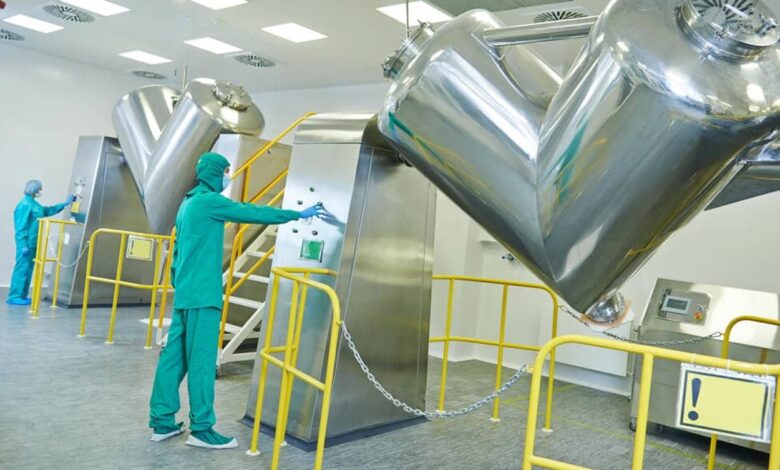The Evolution and Impact of Industrial Mixers in Manufacturing Processes

Industrial mixers play an indispensable role in the manufacturing industry worldwide, finding their way into innumerable factories and production units. Because they are crucial in producing homogenous mixtures from diverse elements, mixers mainly determine the finished product’s texture, quality, and uniformity. In the past, mixer designs have evolved from uncomplicated devices to intricate systems that can handle demanding production requirements. This trajectory represents the remarkable developments in this industry, with industrial mixers becoming increasingly specialized and tailored to meet particular needs.
Read More: How to Choose the Right Industrial Warehousing and Storage Provider
Types of Industrial Mixers and Their Applications
Industrial mixers come in various types, each intended to serve a specific function. The ribbon mixer, renowned for its comprehensive and effective blending capabilities, is among the most adaptable and extensively used in many industries. It is an essential tool in food, pharmaceutical, and building industries since it blends dry powders and wet pastes successfully. A helical mixing ribbon in its design circulates ingredients inside the container to encourage a homogeneous mix. Furthermore, paddle mixers are preferred for softer mixing procedures, while other mixer types—such as the double cone blender—perform well when working with materials that flow freely. Every type of mixer caters to a particular set of material qualities and industrial requirements, which underpins its essential function in maintaining production continuity and efficiency.
The Role of Industrial Mixers in Quality Control
Undoubtedly, using industrial mixers is strongly related to the strict specifications of product quality control. In industries where standards are strictly adhered to, consistency is not only desired but also essential. For example, the healthcare industry is highly dependent on the accuracy of mixers to ensure that active pharmaceutical substances are blended consistently, as even the slightest deviation can pose health hazards. In the food and beverage business, the need for cutting-edge mixing equipment is driven by the desire for consistency from batch to batch. In-depth case studies from various manufacturing environments support the idea that the mixing technology’s effectiveness directly impacts the final product’s integrity.
Material Considerations in Industrial Mixing
Every material combined in the cave-like structures of industrial mixers responds based on its inherent characteristics. The physical and chemical properties of their materials must be understood by producers, regardless of whether they are working with cohesive powders or viscous liquids. If this isn’t done, there could be ineffective mixing, lowered product quality, equipment wear, and ineffective operations. To achieve an ideal mix without compromising the qualities of the final product, consideration should be given to the material’s particle size, density, and flow behaviors while choosing the kind of mixer, the design of the agitator, and the operation parameters.
Advancements in Mixer Technology
The industrial mixing scene of today is characterized by creativity and an effort to push the boundaries of what is conceivable. A discernible trend is the move toward mixers that work well with automated production lines and support complex control systems made possible by Internet of Things (IoT) technologies. These improvements make it possible to monitor and modify in real time, which improves mixing accuracy and customization. Sustainable manufacturing has also influenced new mixer designs, prompting producers to develop more environmentally friendly, energy-efficient systems that maintain mixing efficacy.
Selecting the Right Mixer for Your Manufacturing Needs
Deciding on the proper industrial mixer is a consequential task that demands due diligence. Factors that weigh heavily on this decision include
- The physical state of materials to be mixed.
- The desired speed and thoroughness of the mix.
- Ease of cleaning between batches when working with multiple products.
Many mixer manufacturers offer customization options to serve their clientele’s needs better, leading to enhanced productivity and product quality. Appropriately gauging these varied demands enables companies to make informed investments that cater to their current and future operational needs.
Maintenance and Safety in Industrial Mixing
An industrial mixer’s longevity and consistency in performance lie in the proprietor’s commitment to its maintenance. A preventative maintenance routine can prevent equipment failure and prolong the mixer’s operational life. Safety in the operation of mixers cannot be taken lightly, given the mechanical and chemical risks. Establishing comprehensive training programs for operators and insisting on adherence to safety protocols minimizes the likelihood of workplace accidents and maintains an uninterrupted production line.
Troubleshooting Common Mixer Issues
No matter the sophistication of the mixer technology, disruptions, and malfunctions are inevitable over the equipment’s lifecycle. Operators must possess a working knowledge of the most common mixer issues and their solutions to minimize downtime. Whether it is identifying wear on the mixing elements, dealing with power supply problems, or correcting material loading sequences, effective troubleshooting ensures the continuity of manufacturing processes and protects against costly operational stalls.
The Economic Impact of Efficient Mixing
When an industrial mixer performs at its best, it’s not simply an engineering marvel—it’s a financial boon for the company. Improving the mixing process’s efficiency cascades to increased throughput, reduced waste, and energy savings. These operating cost savings might result in considerable financial rewards when output is increased. As a result, selecting the appropriate mixing equipment involves more than just technical considerations; it also involves strategic business decisions with long- and short-term financial ramifications.
Looking Towards the Future of Industrial Mixing
Industrial mixing has a vibrant and promising future ahead of it. The industry expects to include advanced technologies like machine learning (ML) and artificial intelligence (AI), which could significantly transform mixing procedures. These technologies could result in unprecedented automation, preventive maintenance, and even self-optimizing mixing systems. Trends like these, which look to the future, can propel industrial mixing into a new era of increased efficiency, customization, and precision while highlighting the fantastic potential of mixers like the ribbon blender and its peers.










